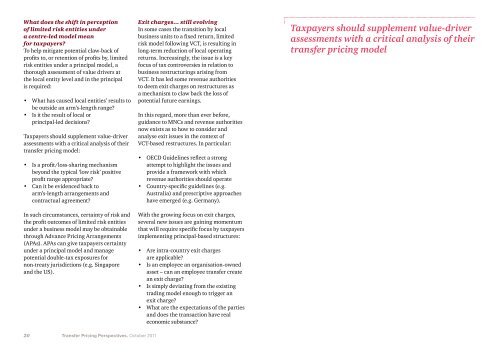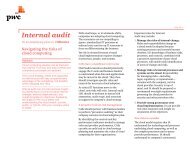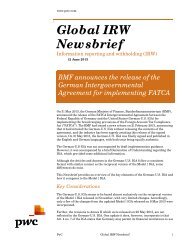Transfer pricing perspectives: Winds of Change - PwC
Transfer pricing perspectives: Winds of Change - PwC
Transfer pricing perspectives: Winds of Change - PwC
You also want an ePaper? Increase the reach of your titles
YUMPU automatically turns print PDFs into web optimized ePapers that Google loves.
What does the shift in perception<strong>of</strong> limited risk entities undera centre‐led model meanfor taxpayers?To help mitigate potential claw‐back <strong>of</strong>pr<strong>of</strong>its to, or retention <strong>of</strong> pr<strong>of</strong>its by, limitedrisk entities under a principal model, athorough assessment <strong>of</strong> value drivers atthe local entity level and in the principalis required:• What has caused local entities’ results tobe outside an arm’s-length range?• Is it the result <strong>of</strong> local orprincipal‐led decisions?Taxpayers should supplement value‐driverassessments with a critical analysis <strong>of</strong> theirtransfer <strong>pricing</strong> model:• Is a pr<strong>of</strong>it/loss-sharing mechanismbeyond the typical ‘low risk’ positivepr<strong>of</strong>it range appropriate?• Can it be evidenced back toarm’s-length arrangements andcontractual agreement?In such circumstances, certainty <strong>of</strong> risk andthe pr<strong>of</strong>it outcomes <strong>of</strong> limited risk entitiesunder a business model may be obtainablethrough Advance Pricing Arrangements(APAs). APAs can give taxpayers certaintyunder a principal model and managepotential double‐tax exposures fornon‐treaty jurisdictions (e.g. Singaporeand the US).Exit charges… still evolvingIn some cases the transition by localbusiness units to a fixed return, limitedrisk model following VCT, is resulting inlong‐term reduction <strong>of</strong> local operatingreturns. Increasingly, the issue is a keyfocus <strong>of</strong> tax controversies in relation tobusiness restructurings arising fromVCT. It has led some revenue authoritiesto deem exit charges on restructures asa mechanism to claw back the loss <strong>of</strong>potential future earnings.In this regard, more than ever before,guidance to MNCs and revenue authoritiesnow exists as to how to consider andanalyse exit issues in the context <strong>of</strong>VCT‐based restructures. In particular:• OECD Guidelines reflect a strongattempt to highlight the issues andprovide a framework with whichrevenue authorities should operate• Country-specific guidelines (e.g.Australia) and prescriptive approacheshave emerged (e.g. Germany).With the growing focus on exit charges,several new issues are gaining momentumthat will require specific focus by taxpayersimplementing principal‐based structures:• Are intra‐country exit chargesare applicable?• Is an employee an organisation-ownedasset – can an employee transfer createan exit charge?• Is simply deviating from the existingtrading model enough to trigger anexit charge?• What are the expectations <strong>of</strong> the partiesand does the transaction have realeconomic substance?Taxpayers should supplement value‐driverassessments with a critical analysis <strong>of</strong> theirtransfer <strong>pricing</strong> model20 <strong>Transfer</strong> Pricing Perspectives. October 2011
















